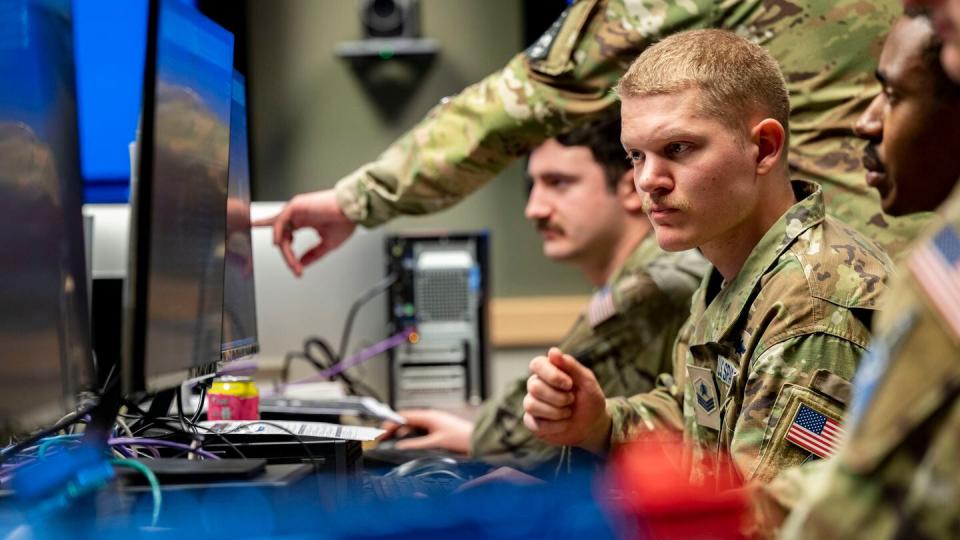It’s time to rebalance funding toward the Air Force and Space Force
It is time to rebalance Department of Defense resources so that our men and women in uniform can fight, if necessary, and win in an increasingly dangerous world. Given the threats posed by China, Russia, Iran, North Korea and an array of nonstate actors, the United States is facing extreme challenges, the likes of which we have never confronted in our history. This threat situation drives a new security environment that requires a revised investment strategy.
Two decades of ground-centric operations saw a dramatic surge in Army spending to the exclusion of sufficient investment in air power and space power. It is time for a reset. Combatant commanders today require more air power and space power — and budgets need to reflect that.
Whether talking about core roles like air superiority, long-range strike, air mobility or two legs of the nuclear triad, the Air Force is essential to the U.S. way of war. Without air power, conflicts stagnate to long and costly attrition warfare like we are seeing in Russia’s invasion of Ukraine.
Similarly, space power underpins all military actions. The Space Force is responsible for achieving space superiority to assure delivery of core missions like communications; intelligence, surveillance, and reconnaissance; missile warning; positioning, navigation and timing; and weather monitoring. These core functions will make or break how the U.S. projects power globally and ultimately performs in a major fight.
Tanks and large infantry formations are simply not as germane in the Pacific region. Of course, we need a sufficient number of these capabilities for other regions, but trade space exists.
In the 20 years after 9/11, the Army received approximately $1.3 trillion more than the Air Force (including the future Space Force functions). Afghanistan and Iraq were land-centric operations, and budgets reflected that. However, this funding shift exacted a cost: an Air Force aircraft inventory that is the oldest and smallest in service history, and a Space Force dramatically undersized given the scale of its mission responsibilities.
Such risks may have made sense when American service members were fighting in Afghanistan and Iraq, but those wars are over. Current challenges demand an ever-increasing amount of air power and space power. In fact, joint power projection will not happen without renewed investment in these two domains. It is time to rebalance funding toward the Air Force and Space Force.

This situation is generally not well understood given that many assume the service departments each receive an equal share of the military budget. The reality, however, is far different.
The Department of the Air Force’s budget, which includes the Space Force and Air Force, includes an incredibly large wedge of money that “passes through” the department to fund efforts elsewhere in the security enterprise. This amounts to over $40 billion per year.
Shift that pass through to where it belongs — defensewide spending — and the Air Force receives 20% of the budget, and the Space Force 3.6% — a total amount that is surpassed by 26% for the category classified as “other DOD functions.”
While these percentages are beginning to shift to the Department of the Air Force’s favor in the proposed fiscal 2025 budget, it may be a case of too little, too late. A major rebalance is necessary to build the required air power and space power capabilities and capacity the global threat environment demands.
Simply adding more money to the overarching defense budget — one possible solution — is likely not to be pursued due to the spending caps legislated by Congress as part of the 2023 Fiscal Responsibility Act. The situation therefore demands internal trades within the DOD topline budget, which will, in and of itself, create challenges. Those losing a portion of the defense budget will not do so absent a strong protest, nor will their advocates in Congress let this happen without a fight. However, higher-order issues are at play, namely winning or losing America’s next war. Winning is not possible without sufficient air power and space power.
Interestingly, in the years following Desert Storm, China recognized it needed to harness similar budgetary trade space between its domains. The People’s Liberation Army shrunk its land force to strengthen naval, air and space forces. Now it is time for the U.S. to follow a similar path.
Just as the U.S. surged money to the Army when it was the predominant means of fighting, now it is time for another rebalance to build the Air Force and Space Force we need, as our ability to succeed in a joint fight against our adversaries now rests on the capabilities and capacity of the Department of the Air Force.
Retired U.S. Air Force Col. Jen Reeves is a senior resident fellow at the Mitchell Institute for Aerospace Studies. She previously served as the chief of program integration for the service.

